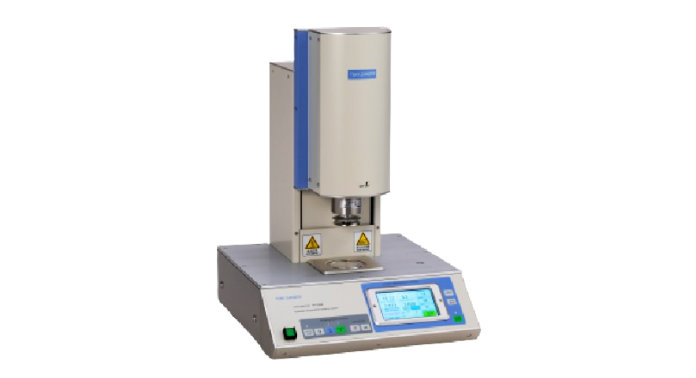The TP-200E viscometer is a cone plate viscometer with an integrated temperature control system.
Space saving has been achieved by eliminating the need for an external constant temperature water tank. (Body width: 358 mm)
A Pelche element plate is used for temperature control, and the temperature can be changed in a short time.
Efficient measurement is also possible when evaluating the dependency between viscosity and temperature.
In addition, the “auto gap” function that automatically sets the gap between the rotor and plate eliminates errors that occur due to differences in operators, enabling more accurate measurements.
Touch panel
Equipped with a 4.3-inch LCD color touch panel, the screen is easy to see and operability has been improved.
Temperature control (Principle of operation of Pelche element)
The Pelche element used for temperature control of the TP-200E transfers heat from one side to the other side when a direct current is passed, heats up on one side and raises the temperature, and absorbs heat on the other side and lowers the temperature. The phenomenon occurs.
By switching the direction and strength of the flowing current, both heating and cooling temperature control is possible.
It features a quick response temperature control.

Since the Pelche element is characterized by a quick response to temperature control, it is possible to perform measurements to evaluate the temperature dependence of viscosity in a short time by using the temperature program of the attached viscosity data acquisition software (Visco-Chart).
Open type plate
The plate on which the sample to be measured is placed is an open type, making it easier to clean.
Auto gap function
In the conventional viscometer, the gap adjustment between the rotor and the plate is an analog adjustment method, so the difference in the operator who adjusts it is one of the causes of error.
With the TP-200E, the “auto gap” function that automatically adjusts the gap enables measurement under the same conditions regardless of who operates it.
Multirange
Depending on the viscosity value of the sample to be measured
Low viscosity:L type
High viscosity:H type
It is divided into two models.
Low viscosity (L type)
“M”, “2.5M”, “5M”
High viscosity (H type)
“H”, “R”, “U”
It covers 3 ranges and
It has a measurement range equivalent to that of three conventional viscometers.
This makes it possible to measure multiple samples with different viscosity values.
In addition, since measurement can be performed at a wide range of rotation speeds (share rate), the range of sample evaluation is expanded.
Operating principle
The viscous torque detector is divided into a drive frame and a sensing frame, which are connected by a flex pivot.
A feedback current flows through the Torquer so that the deviation between the drive frame and the sensing frame generated during measurement becomes zero, pushing the sensing frame back.
This measurement method is a measurement method that always returns the deviation to zero (equilibrium) and is called the “zero position method”.
Due to the “pivotless mechanism” that does not use the jewel bearing used in conventional viscometers, it has excellent linearity and reproducibility even in a wide measurement range.

* The viscosity detection mechanism is the same as the TV-100 / 200 series.

